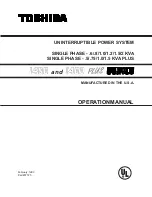
11
4.3. operaTing prinCiple.
This manual describes the installation and operation of SLC
TwIn RT2 series UpSs as devices that can be independently
operated or connected in parallel (for models > 3 kvA). SLC
TwIn RT2 series UpSs ensure optimum protection of any
critical load, maintaining the supply voltage of the loads
between the specified parameters without interruption during
failure, deterioration or fluctuation of mains power, and come
in a wide range of models (from 0.7 kvA to 10 kvA), enabling
the end user to select the model that best suits his needs.
Thanks to their pwm (pulse width modulation) and double-
conversion technology, SLC TwIn RT2 series UpSs are compact,
cool, silent and high performance.
The double converter principle eliminates all mains power
disturbances. A rectifier converts the AC current of the mains
into dC current, thereby maintaining optimum battery charge
level and powering the inverter, which, in turn, generates a
suitable AC sine-wave voltage for continuously powering the
loads. In the event of failure of the UpS’s mains power, the
batteries supply clean power to the inverter.
The design and construction of the SLC TwIn RT2 series UpS
has been carried out in accordance with international standards.
In addition, models with power ratings greater than 3 kvA can
be expanded with the connection of additional modules with
the same power in parallel to obtain n+x redundancy or an
increase in the system’s power.
Thus, this series has been designed to maximise the availability
of critical loads and to ensure that your business is protected
from variations in power distribution line voltage, frequency,
electrical noise, cuts and micro-cuts. This is the primary goal of
SLC TwIn RT2 series UpSs.
This manual applies to the standardised models shown in Tab. 1.
4.4. ups operaTing modes.
•
normal mode.
device running supplying output voltage from the inverter.
mains power present with correct input voltage and
frequency.
•
battery mode.
device running with mains voltage or frequency out of
range or without AC input power, either due to mains
failure or absence of cable connection, supplying output
voltage from the batteries.
•
bypass mode.
device running or not, supplying output voltage directly
from the AC mains.
with the inverter running, this operating mode may be
due to an overload, blockage or inverter fault.
The actions for each incident will be as follows: Reduce
the load connected to the output, unblock the device by
resetting it – stop it and start it up again – and, if the
blockage or fault remains, contact
T.S.S.
with the inverter shut down, the output supplies mains
power directly through the static bypass of the device
provided that it has AC input power.
•
Frequency converter (CF) mode.
operating mode of the UpS as a frequency converter. In
this mode, the static bypass is disabled by the condition of
disparate input and output frequencies.
even if the LCd display on the backlit control panel
shows messages, it does not mean that the inverter is
operational. It is switched on by pressing the ‘on’
button on the control panel, see Chapter 6.
4.4.1. notable features.
•
True on-line with double-conversion technology and output
frequency separate from the mains.
•
output power factor 1, except for b1 models where it is 0.8.
pure sine waveform, suitable for almost all kinds of loads.
•
Input power factor > 0.99 and high overall performance
(between 0.89 and 0.91 for 0.7 to 3 kvA models and > 0.93
for higher power ratings). greater energy savings and lower
user installation costs (wiring), as well as low distortion
of the input current, which reduces pollution in the power
supply network.
•
great adaptability to the worst conditions of the mains.
wide input voltage, frequency and waveform ranges, thus
avoiding excessive dependence on limited battery power.
•
possibility of fast and easy backup extension by adding
modules in rack format. each battery module has two
connectors for easy connection to the device and other
identical modules.
•
Availability of battery chargers of up to 6 A to reduce bat-
tery recharge times.
•
n+x redundant parallel connection to increase reliability
and flexibility in power models > 3 kvA, with a maximum
of 3 devices in parallel.
•
Selectable high-performance mode (eCo mode) > 0.95 to
0.99 depending on model. energy savings, economically
beneficial for the user.
•
possibility of starting the device without mains power
supply or discharged battery. be careful with this aspect
because the greater the batteries are discharged, the more
the backup will be reduced.
•
Intelligent battery management technology is very useful
for extending the life of accumulators and optimising
recharge times.
•
Standard communication options via the RS232 serial port
or USb port.
•
digital input for device Start/Stop and ‘error or fault’ digital
output in models with power ratings > 3 kvA.
•
Remote emergency power off control (epo).
•
Control panel with LCd display available on all models and
Led indicators on devices with power ratings > 3 kvA.
•
Availability of optional connectability cards to improve
communication capabilities.
•
device that can be installed as a tower or rack using the
accessories supplied. The control panel can be rotated to
adapt to either format.
SLC TWIN RT2
UnInTeRRUpTIbLe poweR SUppLy SySTemS (UpS)
USER MANUAL












































